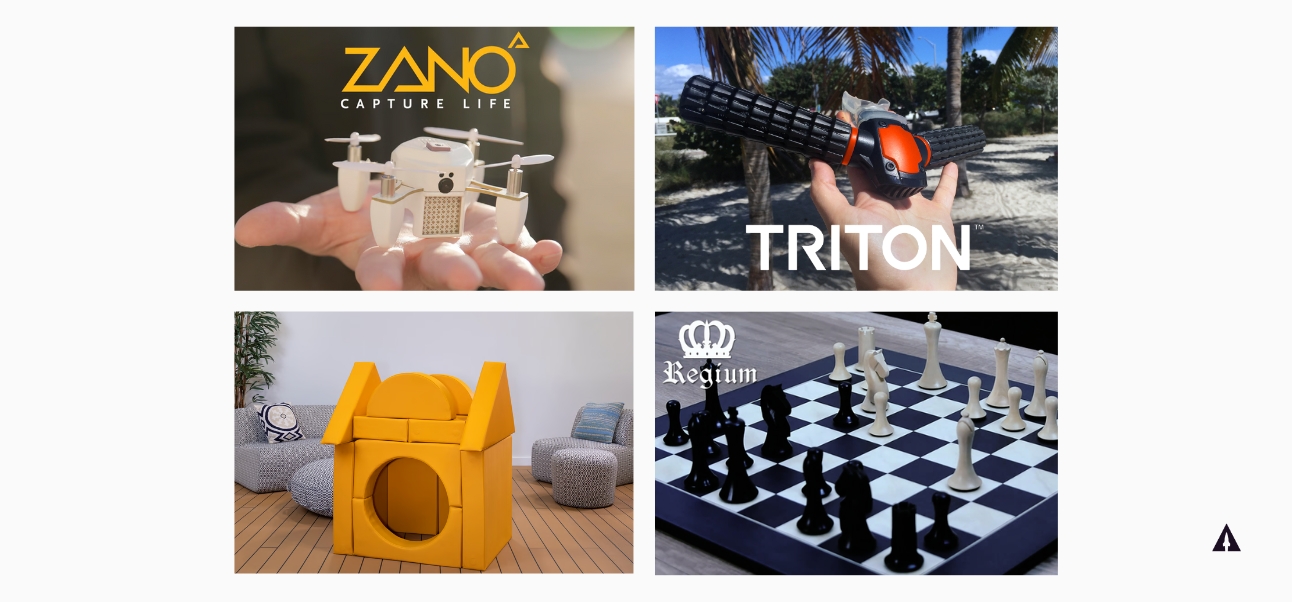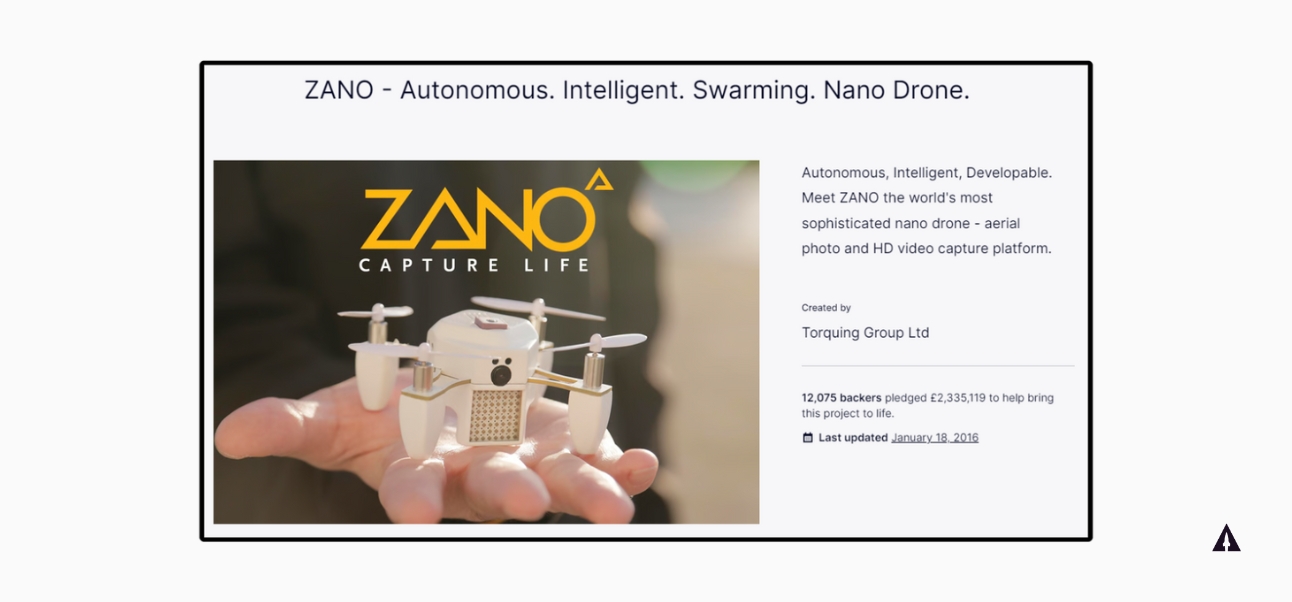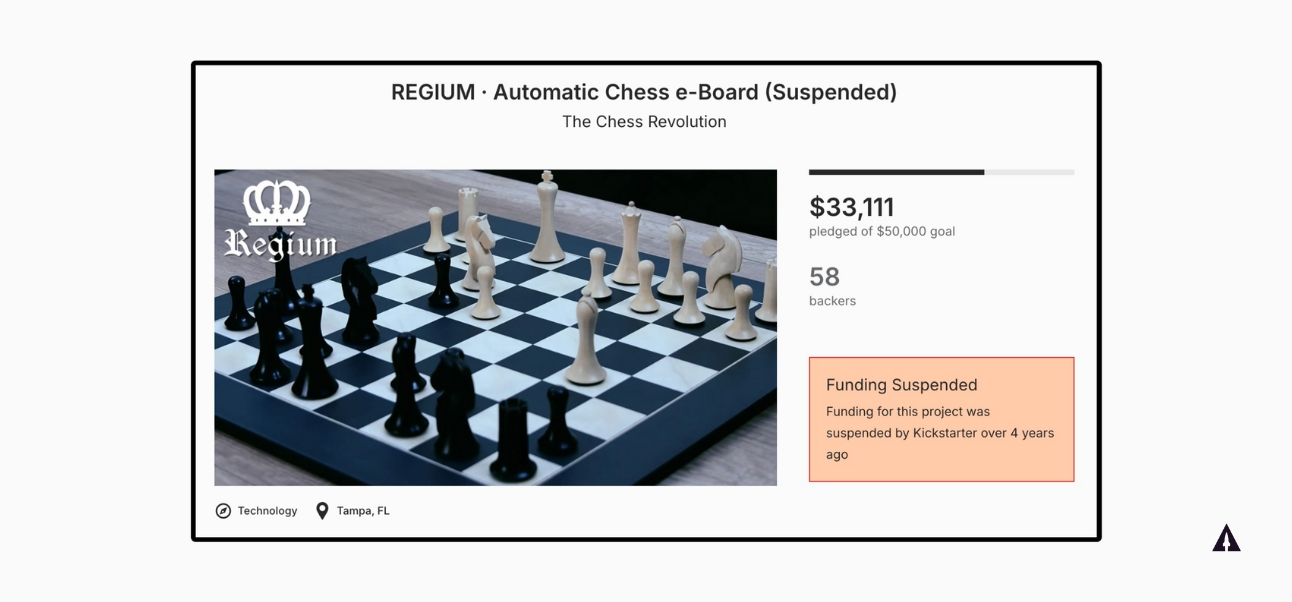
Have you ever spotted a Kickstarter project that seemed too good to be true?
Maybe you’ve seen headlines about crowdfunding scams where backers lost hundreds of dollars. Platforms like Kickstarter and Indiegogo can sometimes feel like the Wild West, but there are valuable lessons we can learn from past mistakes to help prevent future backers from supporting questionable projects.
To learn these lessons, we need to take an objective look at how some of Kickstarter and Indiegogo’s biggest scams happened. In this post we’ll analyze 4 infamous crowdfunding scams, why they happened, and how we can avoid similar cases in the future.
Before I dive in, I also made a video on this topic if you’d rather watch.
Contents
Key Takeaways
- Understand what exactly constitutes a crowdfunding scam
- Navigating the difference between Kickstarter frauds vs. failures
- Learn how to report a Kickstarter project for fraud
What is a Kickstarter scam?

Scams on crowdfunding sites — while rare — are a possibility, and backers should approach each campaign with a healthy level of skepticism. Scams are dishonest schemes where perpetrators purposely benefit themselves. These campaigns present false products with misleading promises to raise as much money as possible in exchange for nothing.
While Kickstarter takes careful measures to prevent the most blatant scammers from ever raising a single dollar, scams have occurred — and may occur in the future. But the most important thing to understand when defining scams is that not all failed campaigns deserve this label. Some Kickstarter campaigns simply fail to bring their product to fruition, leaving backers wondering what happens with their money.
What Is the difference between Kickstarter failures and scams?
In 2015, Kickstarter conducted a study with Professor Ethan Mollick, an entrepreneurship expert from the Wharton School of the University of Pennsylvania. This study aimed to understand how many campaigns actually deliver what they promised.
After surveying 500,000 backers, they made an interesting discovery about the nature of supposed Kickstarter scams. The data revealed that 9% of successful Kickstarter projects failed to deliver after funding, meaning one in ten never shipped what they promised. While this statistic is concerning, it doesn’t necessarily mean that one in ten successful campaigns are complete scams.
Successful campaigns are still susceptible to failure. Failure for honest reasons — while unfortunate — does not mean that the creator was out to scam people from the get-go. Missteps happen, and sometimes creators aren’t able to overcome manufacturing issues, design flaws, or financial blunders.
It’s easy to label something a scam when you don’t get what you paid for, but it’s still helpful to know the difference between the two. You are far more likely to get your money back in the case of a Kickstarter campaign failure than an actual scam. With that said, let’s look at four examples of Kickstarter campaigns that ended with no product being delivered to backers — and why this happened in each case.
The 4 biggest crowdfunding scams and lessons to learn

In an ideal world, there would be no reason to distrust crowdfunding creators. Unfortunately — thanks to some high-profile scams and failures — we have to be cautious about what we back. But that doesn’t mean there aren’t things to learn from these examples. Let’s first look at TRITON, a product that promised breakthrough technology but only ended up breaking down in failure.
1. TRITON — A product that breaks physics

One of the best things about crowdfunding is that it can introduce some incredible new technology to the world. But these artificial gills by TRITON are an important lesson in when to look for scientific credibility.
TRITON’s bold claim was that their product would let people breathe underwater for up to 45 minutes without the need for heavy scuba gear. Naturally, swimmers and divers around the world caught on to this Indiegogo campaign and eagerly backed it, and TRITON went on to raise nearly $1,000,000. Before the campaign finished, though, people started debunking the science underneath the lofty claims.
As people started peeling back the layers, it became clear that this product had valid safety concerns. TRITON immediately started to lose credibility, to which they responded by issuing a full refund to their backers.
Because the creators complied and gave money back to buyers, we wouldn’t label this a scam at this point. But then the creator attempted to launch a second campaign on Indiegogo.
This time they revealed their “secret proprietary technology” that made their product function safely. What was that technology? Liquid oxygen. But this explanation didn’t make sense either. Liquid oxygen is cryogenic, meaning it has to be stored at temperatures below -297°F. This was obviously impossible, but still the second campaign raised nearly $500,000 before being banned by Indiegogo because of community vigilance. That meant that once again, they were forced to refund all of their Indiegogo backers.
What’s the lesson here? If something sounds too good to be true, many times it is. TRITON teaches us that we need to look for credible scientific backing and full product demonstrations before pledging money.
2. FORT — Good intentions, unfortunate results

The FORT campaign from 2021 is an invaluable lesson for not only backers, but creators as well. What started as a bonafide underdog win ended up in failure to fulfill orders for even half of the people that backed the initial campaign. Let’s explore how.
The idea for a magnetic pillow fort for kids captured the hearts of many, and it went on to raise $3,107,079 from 9,859 backers on Kickstarter. Gigantic raises for first time creators sounds like a dream come true, but for the creator, Conor, it was anything but. After the campaign ended, the prices for foam and magnets increased to record highs, and the world was experiencing inflated shipping costs due to the pandemic.
The majority of units sold on Kickstarter were for a 50% discount; Conor hoped to just break even after production in hopes of getting his new business off the ground. This proved to be a fatal mistake after the cost to manufacture ended up being double what he sold his product for. Eventually, the dam started to break as fulfillment delays mounted and complaints about safety and quality started pouring in. After a recall was issued for the product after it was deemed potentially hazardous to children, FORT had to close in 2023.
Although backers lost money, this isn’t so much a lesson in how to avoid a scam since Conor wasn’t out to steal people’s money from the start. FORT’s story is more a cautionary tale in what can go wrong for creators who end up in over their head. Here are three things creators can take away from this Kickstarter failure:
- Be careful with heavy discounting: It’s tempting to want to offer a dream discount of 50% off to incentivize backers, but this much of a discount isn’t necessary for a campaign to perform well. This can leave you barely breaking even, or in the negative after paying to produce and ship all of your orders.
- Charge for shipping later: The pandemic created a shipping and logistics nightmare that has since subsided, but we still always recommend backers to charge for shipping right before it’s time to ship. There is no rule stating you must charge for shipping during a crowdfunding campaign, so don’t take the unnecessary risk of losing money. And while you’re at it, make sure you choose the best time to launch your Kickstarter too.
- Avoid overfunding if you’re a first-timer: Raising a massive amount of money sounds like a dream come true, but it comes with compounded pressure to deal with a volume of orders you might not be equipped to handle. In the case of FORT, Conor simply could not shoulder the burden of manufacturing more than 10,000 units in those market conditions without past experience. Instead, first-timers should aim to only raise what they need. This ensures that when problems with fulfillment eventually arise, it’s much more manageable.
3. ZANO — The super drone that crashed and burned

ZANO, a sophisticated nano drone that went on to become Europe’s most funded crowdfunding campaign at the time, is another example of a failed campaign. It boasted some impressive features, like a compact size, smartphone control, and HD photography — all features that boosted its initial popularity. But its unique value proposition was its purported autonomy and ability to pilot itself.
Their campaign in November 2014 raised about €2.3 million, and gave backers an estimated delivery date of June 2015. Eventually, this date came and went without any post-campaign communication from the ZANO team, and backers started to become concerned. Some orders finally started getting fulfilled the following September, but they were mostly going to people who pre-ordered their drones after the crowdfunding campaign.
On top of ignoring their initial supporters, ZANO’s first round of drones severely underperformed based on the features that they promised on Kickstarter. And in November of 2015, news of the company’s CEO, Ivan Reedman, came out that he was resigning. This finally ended with the company’s liquidation, gaining the ZANO drone its reputation as Kickstarter’s biggest scam at the time.
After an investigation into the campaign took place, it was found that their product launch was not done on the basis of fraud; however, the spectacular failure of the company was rather a result of gross incompetence. In hindsight, it can be argued that the creators did scam their backers in how they marketed their product. They later claimed that the reason for the weaker functionality in the first manufactured units was because they planned to add more sophisticated features in the future once the company was actually making money. None of that was made clear to backers of their crowdfunding campaign.
Like with TRITON, it’s easy to claim a product can do something and entice people to back it. ZANO used a combination of misleading marketing and clever video editing to support the idea that their drones had revolutionary technology, so people bought in. As backers, we need to know when something sounds too good to be true. And as product creators, it’s crucial to never oversell and underdeliver.
4. REGIUM Wonderboard — Blatant deception

Last, we’ll look at the infamous REGIUM Wonderboard, a bonafide scam that ended up fooling the entire chess world. This product was a self-moving chess board tailored for rapid and blitz games online. It rapidly caught the eye of chess enthusiasts everywhere thanks to an enticing video and news of its upcoming crowdfunding campaign got picked up by chess.com. Soon after its Kickstarter campaign started, though, things started to go wrong.
The REGIUM product videos that stirred up so much attention set off red flags for some technical experts and chess enthusiasts. They started looking closer at the feasibility of the product’s technology and immediately began debunking it. A REGIUM demo video turned out to be a collection of stolen videos from other products that were edited together and re-labeled as theirs.
Little by little, more fraudulent activity was brought to light. Four of the people on their team page were discovered to be AI-generated and the company that was purported to have made the REGIUM chess boards came out and confirmed that they never collaborated with a company called REGIUM. In effect, the people behind the REGIUM campaign just bought a chessboard, made some fake promo videos, and started a Kickstarter campaign in order to scam people of their money.
Seven days after their launch, Kickstarter suspended the campaign due to an outpouring of reports from chess enthusiasts claiming that the product was a fraud. Thanks to Kickstarter’s quick actions, everyone who backed the product was able to get their money back since the campaign was still ongoing. This scam serves as a powerful reminder that backers need to have some level of skepticism before backing a product. There were warning signs with REGIUM from the start, but people didn’t stop to consider them.
With this, let’s now springboard into how to spot a crowdfunding scam, and what actions you can take to combat them.
How to easily avoid a Kickstarter scam
Now for the million-dollar question: How do you avoid falling victim to Kickstarter scams? If you’re okay taking financial risks in crowdfunding, you need to do everything you can to mitigate those risks. As backers, we need to train ourselves to be a few steps ahead before deciding if a campaign is legitimate. Here’s a checklist of steps you can do each time for Kickstarter or Indiegogo fraud protection:
- Check the team’s experience: What credentials does the team have? Does the company even exist? These are questions you need to answer — and share with the rest of the crowdfunding community — before backing anything. Additionally, products that involve complex hardware might be too good to be true unless the creators can demonstrate that they’ve successfully manufactured similar products before.
- Verify claims with unedited video: Campaign videos are always an opportunity for savvy creators to make things look a lot better than they really are. Clever editing of product walkthroughs can make something that doesn’t work actually appear like a functioning prototype. Be skeptical if you see this, and try to push the creator to provide unedited video proof.
- Ask yourself if something is really reasonable: Is the creator of a product claiming to have ten cutting-edge features and be able to ship it just one month after crowdfunding? If so, it’s safe to say there are some red flags. It’s likely that others in the community are picking up on the same warning signs, so check to see what others are saying before you buy.
- Check what the campaign is promising: Campaigns that promise too much often fall victim to failing to deliver. Many of the products on crowdfunding sites are being sold by small creators, so be skeptical if one is promising the moon.
- Check if the product already exists: Sometimes, campaigns will try to sell rebranded off-the-shelf products. Look through major online retailers like Amazon and Alibaba to see if this “never-before-seen product” is actually the first of its kind.
And if you do happen to verify that a campaign is probably a scam, it’s important to report it to the platform. If it’s Kickstarter, just scroll to the bottom of the campaign page and click the “Report this project to Kickstarter.” From there, select the category that best applies, i.e. rule breaking, intellectual property violation, or spam or abusive behavior.
Final thoughts on Kickstarter scams
Kickstarter may not be perfect, and crowdfunding is still a participate-at-your-own-risk endeavor even today, but this shouldn’t deter backers and creators alike from overlooking all of the other benefits. We believe crowdfunding is the best way to bring a new product to market. Scammers will always be out there, but thanks to the lessons we’ve learned, we as a community are better equipped to avoid them — and report them before they can do any real damage.
If you’re a creator looking to launch on Kickstarter or Indiegogo, we want to make sure you also avoid making the same mistakes discussed in some of the examples in this post. When you’re ready to get started, just click here to set up a time to speak with one of our product launch experts.
Kickstarter frauds: Frequently asked questions
What was the biggest Kickstarter scam ever?
Arguably one of the biggest Kickstarter frauds in history was the ZANO campaign. The project was plagued with issues, from infrequent updates, to non-functional shipments, to the company going into liquidation just one year after its crowdfunding campaign. This led Kickstarter to commission an independent report to investigate the ZANO case, making this one of the biggest cautionary tales of crowdfunding.
How many people lose money on Kickstarter?
The study by Kickstarter and Professor Mollick uncovered some surprising statistics about failed campaigns and money loss. Some key points include:
- 9% of Kickstarter projects fail to deliver rewards.
- Approximately 8% of dollars pledged on Kickstarter go to failed projects.
- 7% of backers failed to receive their chosen reward.
What is an example of bad crowdfunding?
One infamous example of bad crowdfunding was the Coolest Cooler campaign that launched back in 2014. This cooler promised high-tech features like a built-in blender, waterproof speakers, USB charger, etc., even going on to raise over $13,000,000. However, the project suffered from production issues, financial mismanagement and poor communication. All of this was the perfect recipe for disaster resulting in the Oregon Department of Justice having to reach a settlement with Coolest Cooler, requiring the company to provide refunds to backers who had not received their coolers or were dissatisfied with their product.






